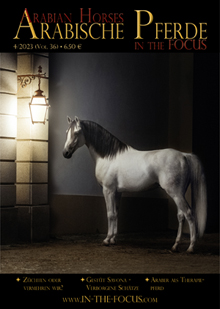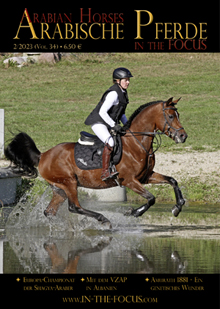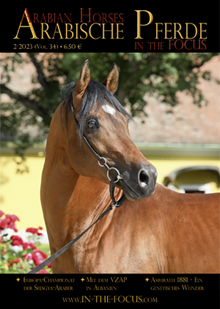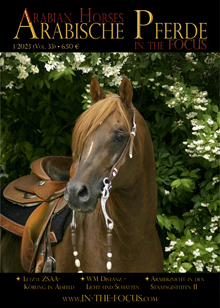Until the beginning of the 19th century, Arabian horses were rather rare in European stables, and more often than not, they actually were Oriental horses or originating from the fringes of the Arabian Peninsula, e.g. from Persia, Turkey or maybe even South Russia or Turkestan. Apart from that, the various authors had different definitions about the meaning of National Arabian, Original Arabian, Arabian horse, Oriental horse, etc.
Just how much historic sources differ about the origin and breed of one of the most significant foundation sires of the Trakehner breed, can be demonstrated with the example of Turcmainatti.
Let’s start with the information, that is (more or less) the same in all sources: Turcmainatti was a bay stallion, who was used as a stud from 1791 to 1806 at the Friedrich Wilhelm Stud at Neustadt/Dosse. He left many offspring and some of his sons were also used as sires. In short: A bad stallion he cannot have been!
In 1796, a booklet was published, titled: “Characteristic and History of the most excellent Stallions and Broodmares of the Royal Prussian Main Stud…” by Helmbrecht and Naumann. Herein we find a detailed description of the stallion, according which he really must have been a fine horse. About his origin we read: “Before, he belonged to the First Imperial Minister Prince Kaunitz-Ritberg and was offered by him to the First Royal Equerry, Count von Lindenau, for the stud.” The horse veterinarian Ammon was sent to Vienna, to have a look at the stallion, but he had concerns to buy him, due to an old injury and consequent lameness. ” Prince [Kaunitz] ordered him, to take the horse with him, and because the stallion had the approval of the First Equerry, he gave him to the Royal Stud…”. “Prince Kaunitz had received him together with some Persian horses as a gift, and he probably comes for the Annecy Arabians [Anazeh Bedouins], who own the best strain of horses. His pedigree was lost, but the information collected about him, testify that he tails back to the famous strain of Dsjülfa…”.

Friedrich Bürde published a series of six etchings in 1823 with the title of ” Illustrations of excellent Horses which are in the Royal Prussian Studs, including five stallions of the Royal Main Stud at Graditz near Torgau and of the National Arabian Turcmainatti”. In this work, he describes him as follows: “TURCMAINATTI, Golden Bay, National Arabian, 5 Feet 3 1/2 inches, was bought by an agent of Prince Kaunitz as a mail nag found somewhere on the road between Egypt and Syria, and then was sent to Europe.”
Rudolph Heine reported in 1870 in the “Journal on Horse Breeding” about Turcmainatti as well, that he once was a “mail nag somewhere between Egypt and Syria”. Further Heine wrote, he “was bought in 1790 in Aleppo for Prince Kaunitz in Vienna, for whom he was too tall as a saddle horse (Turcmainatti measured easily 5 Feet 4 inches). This powerful Minister, who was an equally excellent rider and horseman, valued Turcmainatti highly, as can be proven by the two letters sent by Prince Kaunitz to Count Lindenau.” In one of these letters he praises Turcmainatti into the skies, but also described him as a “cheval asiatique”, i.e. Asian horse. Also, according to Heine, Count Lindenau, at the time First Equerry in Prussia, who received Turcmainatti as a gift, said about him: “Turcmainatti was, however, by no means a son of the desert”.
Friedrich Wilhelm Dünkelberg published in this book “The selection of the horse, in particular the English-Arab thoroughbred” in 1898 yet another story: According to this, the “Arabian stallion” Turcmainatti was bought for Prince Kaunitz by the Austrian Consul, and came as a six-ear-old stallion to Neustadt/Dosse in 1791. “The horse veterinarian Ammon, sent by Count Lindenau to Vienna to buy the stallion, hesitated to buy the horse, because the price of 1,000 ducats seemed to him too high. This annoyed the Prince, who had other offers, too. Trusting, that Count Lindenau would use the stallion best and most, The Prince left the stallion with him as a personal gift and the King bought him for Neustadt, after he was examined in Berlin.” Dünkelberg also recalled the end of the stallion: When the Prussians were beaten by the French under Napoleon in the battle of Jena, one had tried to save the stud’s horses, by hiding them with the farmers of the area. This also happened to Turcmainatty, but due to “an injury at his left front leg, which caused a persistent lameness, he was not able to flee… After his whereabouts were disclosed, he was abducted by some French laggards; one has never heard anything reliable of his later fate.”
But Count C.G. Wrangel reported a totally different story about the stallion in his book “Breeds of Horses”, published in 1908. When, in Neustadt, they were searching for an excellent oriental stallion, “the Austrian Government undertook the effort, to conduct the purchase of such a stallion for Prussia, and it was announced that the stallion Turc-Main-Atti purchased in Damascus, had arrived in Vienna, and could be collected by the Prussians. Professor Naumann was sent to receive the horse. He found a good, bay stallion, 5 feet 2 inches high, who appeared to him – judging from his size, figure and calibre – not to be a purebred oriental horse. Soon after, he was informed secretly by people, who were present during purchase and transport, that he was right, and the animal for sure did not come from Arabia or Turkey, but was brought from Russia to Damascus and most likely originated from the Orlow Stud. He then refused to take the stallion and reported to Berlin accordingly. In the meantime, Prince Kaunitz, the then all-powerful minister of Austria, felt very unpleasant about the whole matter, even more so, said Naumann, because he realized that – if he had inquired more, Turc-Main-Attis origin could have found out by himself. Further, the Austrian Officer, who was commissioned with the purchase was rather compromised. Prince Kaunitz, either himself or by using others, forced the government to give Turc-Main-Atti as a present to Friedrich William II. According to the saying ‘One doesn’t look a gift horse in the mouth’, and because the King liked the stallion very much and did not want his origin to be diminished, also to please Prince Kaunitz, Nauman was ordered to no longer investigate or say anything about the purchase and origin of the stallion. And therefore, Turc-Main-Atti is a “purebred Oriental horse” on paper until today”.
Should we now believe the “official records”, or the stories, that were told at the time of Turcmainattis purchase? This is up to each individually. The truth, we most likely will never know. But this example shows, that historic sources raise sometimes similar problems when it comes to the purity of a horse, as the oral tradition of the Bedouins. It is always a matter of faith and believe!
Gudrun Waiditschka
Dec 30 2015












